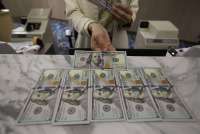INFLATION - WASHINGTON. U.S. import prices dropped for a seventh straight month in January amid declining costs for energy products, leading to the smallest annual increase in imported inflation in two years.
The report from the Labor Department on Friday, however, did little to assuage financial market fears the Federal Reserve could maintain its interest hiking campaign through the summer after data this week showed a jump in monthly consumer and producer prices in January, suggesting a slow disinflation journey.
Import prices fell 0.2% last month after slipping 0.1% in December. The drop in import prices, which exclude tariffs, was in line with economists' expectations.
In the 12 months through January, import prices increased 0.8%. That was the smallest year-on-year gain since December 2020 and followed a 3.0% rise in December.
Read Also: Hawkish ECB Comments Push Up Rate-Hike Expectations
Imported fuel prices dropped 4.9% after declining 4.4% in December. Petroleum prices fell 4.5%, while natural gas tumbled 11.2%. The cost of imported food surged 1.3%.
Excluding fuel and food, import prices gained 0.2%. These so-called core import prices rose 0.4% in December. Core import prices have now increased for two straight months, likely reflecting the dollar's recent weakness against the currencies of the United States' main trade partners.
The Fed has raised its policy rate by 450 basis points since last March from near zero to a 4.50%-4.75% range, with the bulk of the increases between May and December. Though two additional rate hikes of 25 basis points are expected in March and May, financial markets are betting on another increase in June.
Read Also: Indonesia's J&T Express Aims to Raise at Least $1 bln in Hong Kong IPO - Sources
RECESSION RISKS REMAIN
Data this month have suggested strength in the economy at the start of the year, with robust job growth and retail sales gains. But the economy remains in danger of falling into recession this year.
A report from the Conference Board on Friday showed its leading economic index, a gauge of future economic activity, dropped 0.3% in January after falling 0.8% in December. The leading indicator has declined 3.6% over the last six months.
Still, the persistent strength in the labor market and high inflation prompted some economists, including those at Bank of America Securities, to forecast a rate hike in June.
"March and May hikes appear very likely, and the Fed might have to hike further if inflation, job growth and consumer demand refuse to soften," Bank of America Securities said in a note. "We are adding a 25 basis point hike in June to our forecast."
Prices of imported capital goods increased in January and there was 0.6% jump in the cost of motor vehicles. Consumer goods prices, excluding automotives, gained 0.2%.
Read Also: GoTo's Profitability Target by the End of 2023 Seen to Surpass GRAB and SEA Group
The cost of imported goods from China fell 0.4%, the largest monthly drop since November 2016. That reflected a 2.3% decline in the price of communications equipment manufacturing. Prices for imports from the European Union surged 1.3%, while the cost of goods from Mexico rose 0.8%.
"These data provide no encouragement for those looking for manufactured goods price increases to subside to pre-pandemic trends on an easing of supply-chain constraints," said Conrad DeQuadros, senior economic advisor at Brean Capital in New York.
The Labor Department also reported that export prices rebounded 0.8% in January, after declining for six straight months. Prices for agricultural exports fell 0.2% as a 21.6% plunge in vegetable prices more than offset higher prices for soybeans and corn.
Nonagricultural export prices increased 0.8%, lifted by industrial supplies and materials, capital goods, automotive vehicles and consumer goods.
Export prices rose 2.3% year-on-year, the smallest gain since December 2020, after increasing 4.3% in December.
/2017/07/31/1926588778p.jpg)









